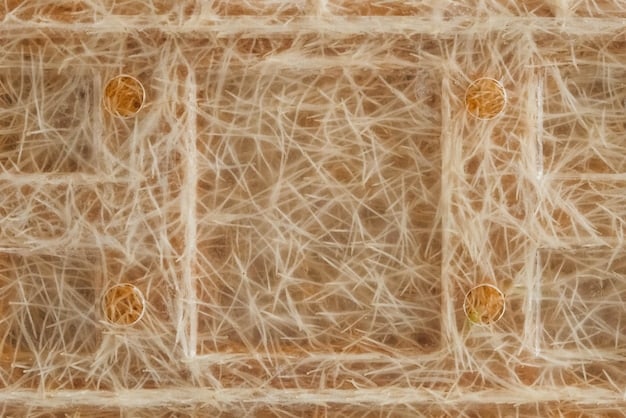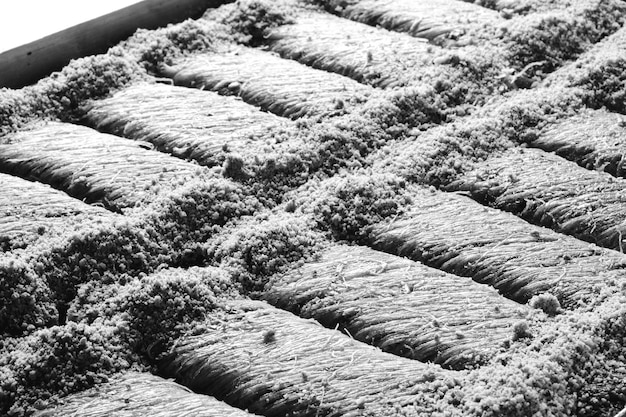Winter 2025 Outerwear Guide: Insulation Tech for US Climates

The Winter 2025 Outerwear Guide explores the latest insulation technologies, focusing on how they perform across various US climates, ensuring consumers make informed choices for optimal warmth and comfort.
As winter approaches, understanding the technology behind your outerwear is crucial for staying comfortable in diverse climates. This Winter 2025 Outerwear Guide: Decoding the Latest Insulation Technologies for US Climates will help you navigate the options.
Understanding Insulation: The Key to Winter Warmth
Insulation is the heart of any winter outerwear, trapping heat to keep you warm. With advancements in materials and construction, there are more choices than ever before. This section breaks down the basics of insulation types and their effectiveness.
Types of Insulation Materials
Understanding the properties of different insulation materials can help you choose the right outerwear for your needs. From natural options to synthetics, each has specific advantages.
- Down Insulation: Known for its excellent warmth-to-weight ratio, down is a natural insulator that traps air effectively.
- Synthetic Insulation: These materials, like PrimaLoft and Thinsulate, offer warmth even when wet, making them ideal for damp conditions.
- Wool Insulation: A natural fiber that provides warmth and breathability, wool is also odor-resistant and sustainable.
Consider the conditions you’ll be facing to determine the best insulation material for your outerwear. Each type has its pros and cons, so it’s important to evaluate what’s suitable for your climate and activity level.

Choosing insulation involves balancing factors like weight, warmth, and moisture resistance. The right choice ensures you stay comfortable and protected throughout the winter season.
Down Insulation: Natural Warmth and Performance
Down insulation remains a popular choice for its exceptional warmth-to-weight ratio and compressibility. It’s sourced from the undercoating of ducks or geese, providing excellent thermal efficiency in cold conditions.
Fill Power and Quality
Fill power is a crucial metric for assessing the quality of down insulation. It measures the loft, or fluffiness, of the down, indicating how effectively it can trap air and provide warmth.
- Higher Fill Power: Down with a fill power of 700 or more is considered high quality, offering superior warmth and compressibility.
- Lower Fill Power: Down with a fill power below 550 is generally less effective, requiring more material to achieve the same level of warmth.
- Ethical Sourcing: Look for down that is certified by the Responsible Down Standard (RDS) to ensure humane treatment of animals.
Choosing down with a high fill power ensures that your outerwear is both lightweight and exceptionally warm, making it suitable for a wide range of winter activities. Proper care can extend the life of down-filled garments, maintaining their insulating properties for years.
Synthetic Insulation: Versatility in Wet Conditions
Synthetic insulation offers a valuable alternative to down, particularly in wet or damp environments. These materials are engineered to maintain their insulating properties even when exposed to moisture, providing reliable warmth in challenging conditions.
Key Synthetic Insulation Technologies
Several innovative synthetic insulation technologies are available, each with unique properties and benefits for winter outerwear. Understanding these technologies can help you choose the right jacket for your needs.
- PrimaLoft: Known for its excellent warmth-to-weight ratio and water resistance, PrimaLoft is a popular choice for high-performance outerwear.
- Thinsulate: This lightweight and compressible insulation provides warmth without bulk, making it ideal for streamlined designs.
- Coreloft: Developed by Arc’teryx, Coreloft is a resilient insulation that retains its loft and warmth even after repeated compression and washing.
Synthetic insulation has evolved significantly, offering performance that rivals down in many situations. Its ability to maintain warmth when wet makes it a practical choice for those who encounter unpredictable weather conditions.

Selecting the right synthetic insulation can enhance the versatility of your winter outerwear, ensuring you stay warm and comfortable in diverse conditions. Consider your typical activities and climate to choose the technology that best suits your needs.
Climate Considerations: Choosing Insulation for Your Region
The ideal insulation for your winter outerwear depends heavily on the specific climate you’ll be facing. Different regions of the US experience vastly different winter conditions, requiring tailored insulation strategies.
Regional Climate Profiles
Understanding the typical winter conditions in your region is crucial for selecting the right outerwear. Consider factors such as temperature, precipitation, and humidity to make an informed decision.
- Northeast: Cold temperatures, heavy snowfall, and high humidity make waterproof and highly insulated outerwear essential.
- Midwest: Extremely cold temperatures and strong winds necessitate outerwear with excellent wind resistance and high levels of insulation.
- Pacific Northwest: Mild temperatures and frequent rain require waterproof outerwear with moisture-resistant insulation.
- Southwest: Mild temperatures and dry conditions allow for lighter insulation options, focusing on breathability and versatility.
By matching your outerwear’s insulation to your regional climate, you can ensure optimal comfort and protection throughout the winter season. Consider layering options to adapt to changing conditions and diverse activities.
Beyond Insulation: Outerwear Features for 2025
While insulation is the primary determinant of warmth, other features of your outerwear play a vital role in comfort and performance. These elements enhance protection, improve mobility, and add convenience to your winter gear.
Essential Outerwear Features
Several key features can significantly enhance the functionality of your winter outerwear. Look for these elements when selecting your jacket or coat to ensure optimal performance.
- Waterproof/Breathable Membranes: These materials protect against moisture while allowing vapor to escape, keeping you dry and comfortable.
- Adjustable Hoods and Cuffs: Customizable features allow you to seal out the elements and tailor the fit to your preferences.
- Pockets and Storage: Strategically placed pockets provide convenient storage for essential items, such as gloves, phones, and wallets.
Waterproof zippers, reinforced elbows, and articulated designs are other features to consider for enhanced durability and mobility. A well-designed outerwear piece integrates these elements seamlessly to provide comprehensive protection and comfort.
Layering Strategies: Maximizing Warmth and Versatility
Layering is a fundamental strategy for managing warmth and comfort in varying winter conditions. By combining multiple layers of clothing, you can easily adapt to changing temperatures and activity levels.
Effective Layering Techniques
Understanding the principles of layering can help you create a versatile and adaptable winter wardrobe. Each layer serves a specific purpose, working together to keep you warm and dry.
- Base Layer: A moisture-wicking base layer, such as merino wool or synthetic fabric, helps to regulate body temperature and prevent sweat buildup.
- Mid Layer: An insulating mid layer, such as fleece or down, provides warmth by trapping air and retaining body heat.
- Outer Layer: A waterproof and windproof outer layer protects against the elements, shielding you from rain, snow, and wind.
Additional layers, such as insulated vests or sweaters, can be added for extra warmth in extremely cold conditions. Experiment with different combinations to find the layering system that works best for your body and activities.
Caring for Your Outerwear: Maintaining Performance and Longevity
Proper care is essential for maintaining the performance and longevity of your winter outerwear. Following the manufacturer’s instructions and using appropriate cleaning products can preserve the insulating properties and waterproof qualities of your gear.
Care Tips for Different Insulation Types
Each type of insulation requires specific care to ensure optimal performance. Refer to the garment’s care label for detailed instructions and recommendations.
- Down: Use a down-specific detergent and tumble dry on low heat with dryer balls to restore loft.
- Synthetic: Machine wash with mild detergent and tumble dry on low heat or hang to dry.
- Waterproof Fabrics: Use a waterproof fabric cleaner and reapply a durable water repellent (DWR) finish as needed.
Avoid using fabric softeners or bleach, as these can damage the insulation and waterproof membranes. Store your outerwear in a dry, well-ventilated area to prevent mildew and maintain its shape.
| Key Point | Brief Description |
|---|---|
| ❄️ Insulation Types | Down, synthetic, and wool each offer unique warmth and moisture-resistance. |
| 🌧️ Climate Needs | Match insulation to your region’s winter conditions for optimal comfort. |
| 🧥 Key Features | Waterproof membranes, adjustable cuffs, and ample pockets enhance outerwear performance. |
| 🧣 Layering | Use base, mid, and outer layers to adapt to changing temperatures. |
Frequently Asked Questions
▼
For consistently cold climates, high-fill-power down insulation provides superior warmth-to-weight ratio. Layering with a quality base and mid-layer can further enhance insulation in extreme conditions.
▼
Wash your down jacket with a down-specific detergent, tumble dry on low heat with dryer balls to prevent clumping and restore loft. Ensure the jacket is completely dry before storing it.
▼
While down generally offers a higher warmth-to-weight ratio, high-quality synthetic insulations like PrimaLoft can provide comparable warmth and perform better in wet conditions.
▼
Look for a jacket with a waterproof/breathable membrane, sealed seams, waterproof zippers, and an adjustable hood and cuffs to keep moisture out. A durable water repellent (DWR) finish is also beneficial.
▼
Check for certifications such as the Responsible Down Standard (RDS) for down products. Brands committed to ethical sourcing often provide detailed information about their supply chain and practices.
Conclusion
Choosing the right winter outerwear involves understanding insulation technologies, climate considerations, and essential features. By carefully evaluating your needs and preferences, you can find the perfect jacket or coat to keep you warm and comfortable throughout the winter season. The Winter 2025 Outerwear Guide: Decoding the Latest Insulation Technologies for US Climates provides valuable insights for making informed decisions.





